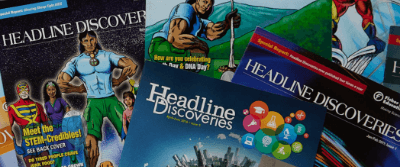Celebrating 20 Years of Headline Discoveries

By Christina P. Hooton
Just like any subject you learn about in school, science is best taught and understood with real-world examples. According to futureeducators.org, using authentic scenarios can help make learning more meaningful for students and spark excitement in the classroom. This makes it easier for teachers to engage students with abstract scientific topics.
That was the original inspiration behind Headline Discoveries. Now embarking on its next decade of educational science news, this publication has been helping teachers and inspiring students in science for 20 years. Learn how it originated and has evolved over its impressive run.
Inspiring Teachers and Students
Headline Discoveries launched in 2004 to provide science educators with a classroom teaching aid. Jill Jones, then category manager of the Fisher Science Education brand, who helped launch the publication, used her experience developing programs at the Carnegie Science Center in Pittsburgh, Pennsylvania, to better understand the challenges of elementary school teachers trying to teach and be well-versed in multiple subject areas.
“We realized there is a lot of content in the news that has great nuggets of information that teachers can learn from and, most importantly, share with their students,” said Jones, now vice president of sales for academic and government segments at Thermo Fisher Scientific. “Headline Discoveries was designed to give teachers real-world current science content and get students excited about what they’re learning and how it impacts the world.”
The publication first launched as a newspaper, the environmentally conscious choice at the time, with four issues per year. It featured many of the same topics you see today, including biology, chemistry, physical science, and more. Originally, its audience was elementary school students and teachers, but the publication has since evolved to include articles for high-school and college students as well.
“The articles have also changed over the years, going from short snippets to longer pieces, including editorials,” said Celeste Beley, market development manager for the Fisher Science Education brand at Thermo Fisher. “Vocabulary words and discussion questions were added to give teachers the option to turn the articles into content literacy tools.”
The publication was only available in print until 2012 when the Headline Discoveries web page first launched. It straddled both the print and digital worlds until the end of 2020 when it transitioned to being entirely online. This move reflects the commitment of the Fisher Science Education brand, as part of Thermo Fisher Scientific, to achieve net-zero emissions by 2050.
Honoring Teachers as Superheroes
Headline Discoveries has existed in various forms and designs over the years, too, even featuring different science superheroes on its covers. The STEMcredibles had superpowers inspired by different disciplines of science.
“At the time, teachers were feeling underappreciated and underpaid. With these characters, we created a persona that honored teachers as superheroes,” said Jones.
When the Fisher Science Education team visited trade shows, they brought their banner exclaiming “Science Teachers Are Superheroes Every Day,” and teachers lined up to have their photos taken with the sign, sometimes in their own superhero gear, said Jones.
The campaign won the team a coveted Markie award, an honor granted by Oracle for customer experience innovation and excellence in advertising, marketing, sales, service, and e-commerce.
Over the years, the Headline Discoveries design evolved and matured with its growing audience, including college students.
Tackling Tough Topics and Tough Times
During the pandemic, Headline Discoveries remained a steady resource and online tool for educators who were being tasked with teaching remotely. As the Black Lives Matter movement took shape around the same time, the Fisher Science Education team did not shy away from the conversation. They published a cover article discussing how racism is a product of culture not science.
Presenting unbiased scientific facts has always been a driving force behind the publication and always will be.
Looking Toward the Future
As the world around us changes, we will continue to highlight topics that really matter to you. Articles that delve into the science behind climate change will undoubtedly continue to fill our pages. New applications of artificial intelligence in the science and education world will certainly be present, too. We can’t predict what’s to come next, but one thing we can say for sure is we’re excited for the next 20 years of bringing real-world science into your classrooms.
Discussion Questions
- What makes learning about science using real-world examples so effective?
- Imagine that you are a science teacher. Brainstorm ways to make learning more engaging for students in your grade.